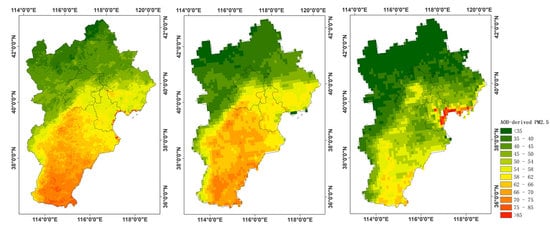Influence of Spatial Resolution and Retrieval Frequency on Applicability of Satellite-Predicted PM2.5 in Northern China
Abstract
:1. Introduction
2. Data and Methods
2.1. Study area and Ground Sites
2.2. MODIS AOD Datasets
2.3. Statistical Model and Validation
3. Results and Analysis
3.1. Descriptive Statistics
3.2. Model Fitting and PM2.5 Prediction with Different MODIS AOD Products
3.3. Inlfuence of MODIS AOD Selection on PM2.5 Predication
4. Discussion
5. Conclusions
Author Contributions
Funding
Acknowledgments
Conflicts of Interest
References
- Peters, A.; Dockery, D.; Muller, J.E.; Mittleman, M.A. Increased particulate air pollution and the triggering of myocardial infarction. Circulation 2001, 103, 2810–2815. [Google Scholar] [CrossRef] [Green Version]
- Iii, C.A.P.; Burnett, R.T.; Thun, M.J.; Calle, E.E.; Krewski, D.; Ito, K.; Thurston, G.D.; Pope, C.A. Lung Cancer, Cardiopulmonary Mortality, and Long-term Exposure to Fine Particulate Air Pollution. JAMA 2002, 287, 1132–1141. [Google Scholar]
- Tao, M.; Chen, L.; Su, L.; Tao, J. Satellite observation of regional haze pollution over the North China Plain. J. Geophys. Res. Space Phys. 2012, 117, 12203. [Google Scholar] [CrossRef]
- Tao, M.; Chen, L.; Xiong, X.; Zhang, M.; Ma, P.; Tao, J.; Wang, Z. Formation process of the widespread extreme haze pollution over northern China in January 2013: Implications for regional air quality and climate. Atmospheric Environ. 2014, 98, 417–425. [Google Scholar] [CrossRef]
- Tao, M.; Chen, L.; Li, R.; Wang, L.; Wang, J.; Wang, Z.; Tang, G.; Tao, J. Spatial oscillation of the particle pollution in eastern China during winter: Implications for regional air quality and climate. Atmospheric Environ. 2016, 144, 100–110. [Google Scholar] [CrossRef] [Green Version]
- Hoff, R.M.; Christopher, S.A.; Hidy, G.; Sharma, P.; Poulsen, T.; Kalluri, P.; Hoff, S.; Bundy, D.; Nelson, M.; Zelle, B.; et al. Remote Sensing of Particulate Pollution from Space: Have We Reached the Promised Land? J. Air Waste Manag. Assoc. 2009, 59, 645–675. [Google Scholar] [CrossRef] [PubMed]
- Wang, J.; Christopher, S.A. Intercomparison between satellite-derived aerosol optical thickness and PM2.5 mass: Implications for air quality studies. Geophys. Res. Lett. 2003, 30. [Google Scholar] [CrossRef]
- Van Donkelaar, A.; Martin, R.V.; Brauer, M.; Kahn, R.; Levy, R.; Verduzco, C.; Villeneuve, P.J. Global Estimates of Ambient Fine Particulate Matter Concentrations from Satellite-Based Aerosol Optical Depth: Development and Application. Environ. Heal. Perspect. 2010, 118, 847–855. [Google Scholar] [CrossRef] [Green Version]
- Lee, H.J.; Liu, Y. B.; Coull, A.; Schwartz, J.; Koutrakis, P. A novel calibration approach of MODIS AOD data to predict PM2.5 concentrations. Atmos. Chem. Phys. 2011, 11, 7991–8002. [Google Scholar] [CrossRef] [Green Version]
- Li, R. Estimating Ground-Level PM2.5 Using Fine-Resolution Satellite Data in the Megacity of Beijing, China. Aerosol Air Qual. Res. 2015, 15, 1347–1356. [Google Scholar] [CrossRef] [Green Version]
- Hu, X.; Waller, L.A.; Al-Hamdan, M.Z.; Crosson, W.L., Jr.; Estes, S.M.; Quattrochi, D.; Sarnat, J.A.; Liu, Y. Estimating ground-level PM2.5 concentrations in the southeastern U.S. using geographically weighted regression. Environ. Res. 2013, 121, 1–10. [Google Scholar] [CrossRef] [PubMed]
- You, W.; Zang, Z.; Zhang, L.; Li, Y.; Pan, X.; Wang, W. National-Scale Estimates of Ground-Level PM2.5 Concentration in China Using Geographically Weighted Regression Based on 3 km Resolution MODIS AOD. Remote. Sens. 2016, 8, 184. [Google Scholar] [CrossRef] [Green Version]
- Li, T.; Shen, H.; Yuan, Q.; Zhang, X.; Zhang, L. Estimating Ground-Level PM2.5by Fusing Satellite and Station Observations: A Geo-Intelligent Deep Learning Approach. Geophys. Res. Lett. 2017, 44, 11985–11993. [Google Scholar] [CrossRef] [Green Version]
- Guo, Y.; Tang, Q.; Gong, D.; Zhang, Z. Estimating ground-level PM2.5 concentrations in Beijing using a satellite-based geographically and temporally weighted regression model. Remote. Sens. Environ. 2017, 198, 140–149. [Google Scholar] [CrossRef]
- He, Q.; Huang, B. Satellite-based high-resolution PM2.5 estimation over the Beijing-Tianjin-Hebei region of China using an improved geographically and temporally weighted regression model. Environ. Pollut. 2018, 236, 1027–1037. [Google Scholar] [CrossRef]
- Tao, M.; Wang, Z.; Tao, J.; Chen, L.; Wang, J.; Hou, C.; Wang, L.; Xu, X.; Zhu, H. How Do Aerosol Properties Affect the Temporal Variation of MODIS AOD Bias in Eastern China? Remote. Sens. 2017, 9, 800. [Google Scholar] [CrossRef] [Green Version]
- Tao, M.; Chen, L.; Wang, Z.; Tao, J.; Che, H.; Wang, X.; Wang, Y. Comparison and evaluation of the MODIS Collection 6 aerosol data in China. J. Geophys. Res. Atmos. 2015, 120, 6992–7005. [Google Scholar] [CrossRef]
- Song, Z.; Fu, D.; Zhang, X.; Han, X.; Song, J.; Zhang, J.; Wang, J.; Xia, X. MODIS AOD sampling rate and its effect on PM2.5 estimation in North China. Atmospheric Environ. 2019, 209, 14–22. [Google Scholar] [CrossRef]
- Tao, M.; Wang, J.; Li, R.; Wang, L.; Wang, L.; Wang, Z.; Tao, J.; Che, H.; Chen, L. Performance of MODIS high-resolution MAIAC aerosol algorithm in China: Characterization and limitation. Atmospheric Environ. 2019, 213, 159–169. [Google Scholar] [CrossRef]
- Levy, R.C.; Mattoo, S.; Munchak, L.A.; Remer, L. A.; Sayer, A.M.; Patadia, F.; Hsu, N.C. The Collection 6 MODIS aerosol products over land and ocean. Atmos. Meas. Tech. 2013, 6, 2989–3034. [Google Scholar] [CrossRef] [Green Version]
- Remer, L.A.; Mattoo, S.; Levy, R.; Munchak, L.A. MODIS 3 km aerosol product: algorithm and global perspective. Atmospheric Meas. Tech. 2013, 6, 1829–1844. [Google Scholar] [CrossRef] [Green Version]
- Hsu, N.C.; Jeong, M.-J.; Bettenhausen, C.; Sayer, A.; Hansell, R.; Seftor, C.S.; Huang, J.; Tsay, S.-C. Enhanced Deep Blue aerosol retrieval algorithm: The second generation. J. Geophys. Res. Atmos. 2013, 118, 9296–9315. [Google Scholar] [CrossRef]
- Chudnovsky, A.A.; Kostinski, A.; Lyapustin, A.; Koutrakis, P. Spatial scales of pollution from variable resolution satellite imaging. Environ. Pollut. 2013, 172, 131–138. [Google Scholar] [CrossRef] [PubMed]
- Chudnovsky, A.; Tang, C.; Lyapustin, A.; Wang, Y.; Schwartz, J.; Koutrakis, P. A critical assessment of high-resolution aerosol optical depth retrievals for fine particulate matter predictions. Atmospheric Chem. Phys. Discuss. 2013, 13, 10907–10917. [Google Scholar] [CrossRef] [Green Version]
- Wu, J.; Liang, J.; Zhou, L.; Yao, F.; Peng, J. Impacts of AOD Correction and Spatial Scale on the Correlation between High-Resolution AOD from Gaofen-1 Satellite and In Situ PM2.5 Measurements in Shenzhen City, China. Remote. Sens. 2019, 11, 2223. [Google Scholar] [CrossRef] [Green Version]
- Mei, L.; Strandgren, J.; Rozanov, V.; Vountas, M.; Burrows, J.P.; Wang, Y. A study of the impact of spatial resolution on the estimation of particle matter concentration from the aerosol optical depth retrieved from satellite observations. Int. J. Remote. Sens. 2019, 40, 7084–7112. [Google Scholar] [CrossRef]
- Lyapustin, A.; Wang, Y.; Korkin, S.; Huang, N. MODIS Collection 6 MAIAC algorithm. Atmospheric Meas. Tech. 2018, 11, 5741–5765. [Google Scholar] [CrossRef] [Green Version]
- Wu, J.; Yao, F.; Li, W.; Si, M. VIIRS-based remote sensing estimation of ground-level PM2.5 cocentrations in Beijing-Tianjin-Hebei: a spatiotemporal statistical model. Remote Sens. Environ. 2016, 184, 316–328. [Google Scholar] [CrossRef]
- Park, S.; Shin, M.; Im, J.; Song, C.-K.; Choi, M.; Kim, J.; Lee, S.; Park, R.; Kim, J.; Lee, N.-W.; et al. Estimation of ground-level particulate matter concentrations through the synergistic use of satellite observations and process-based models over South Korea. Atmospheric Chem. Phys. Discuss. 2019, 19, 1097–1113. [Google Scholar] [CrossRef] [Green Version]
- Gupta, P.; Christopher, S.A. An evaluation of Terra-MODIS sampling for monthly and annual particulate matter air quality assessment over the Southeastern United States. Atmospheric Environ. 2008, 42, 6465–6471. [Google Scholar] [CrossRef]
- Xie, Y.; Wang, Y.; Bilal, M.; Dong, W. Mapping daily PM2.5 at 500 m resolution over Beijing with improved hazy day performance. Sci. Total Environ. 2019, 659, 410–418. [Google Scholar] [CrossRef] [PubMed]



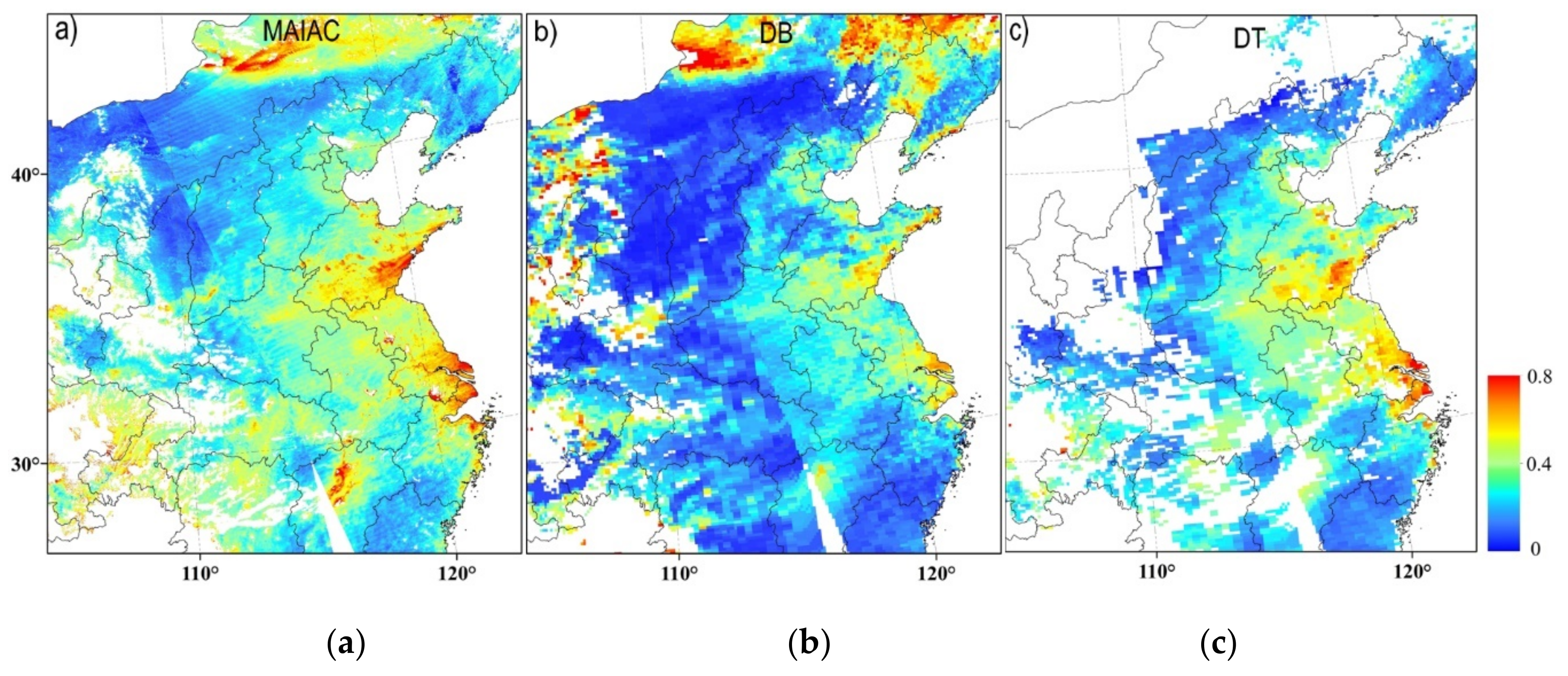
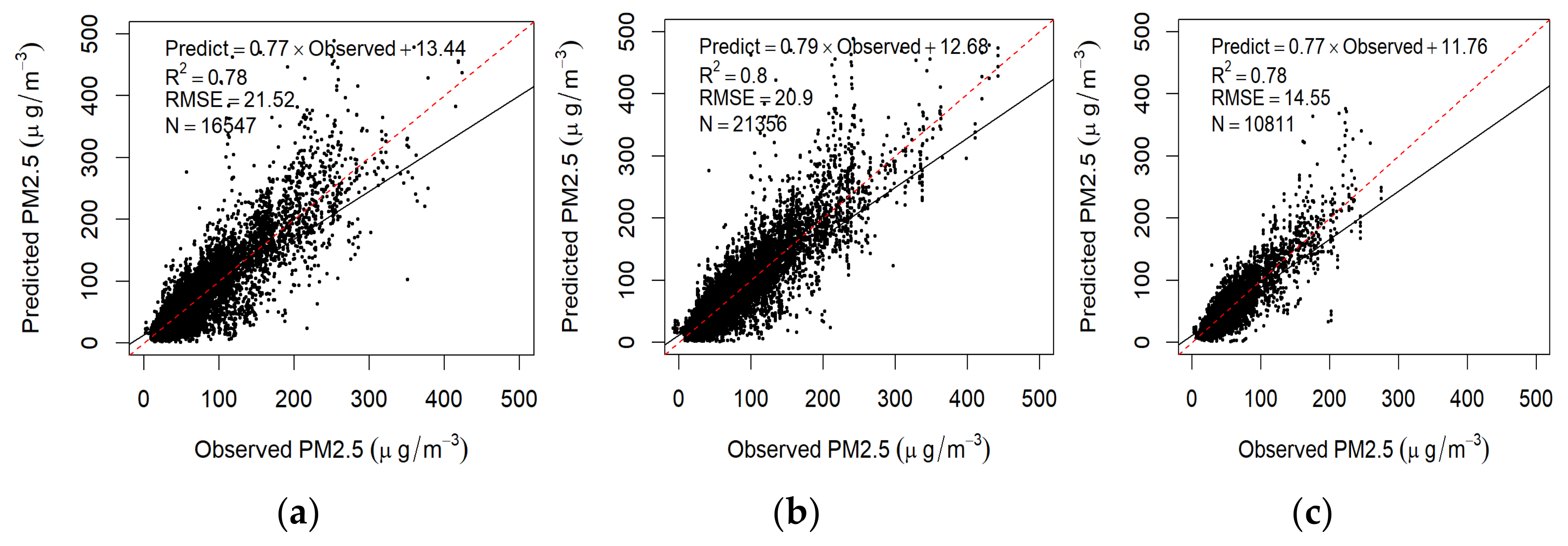

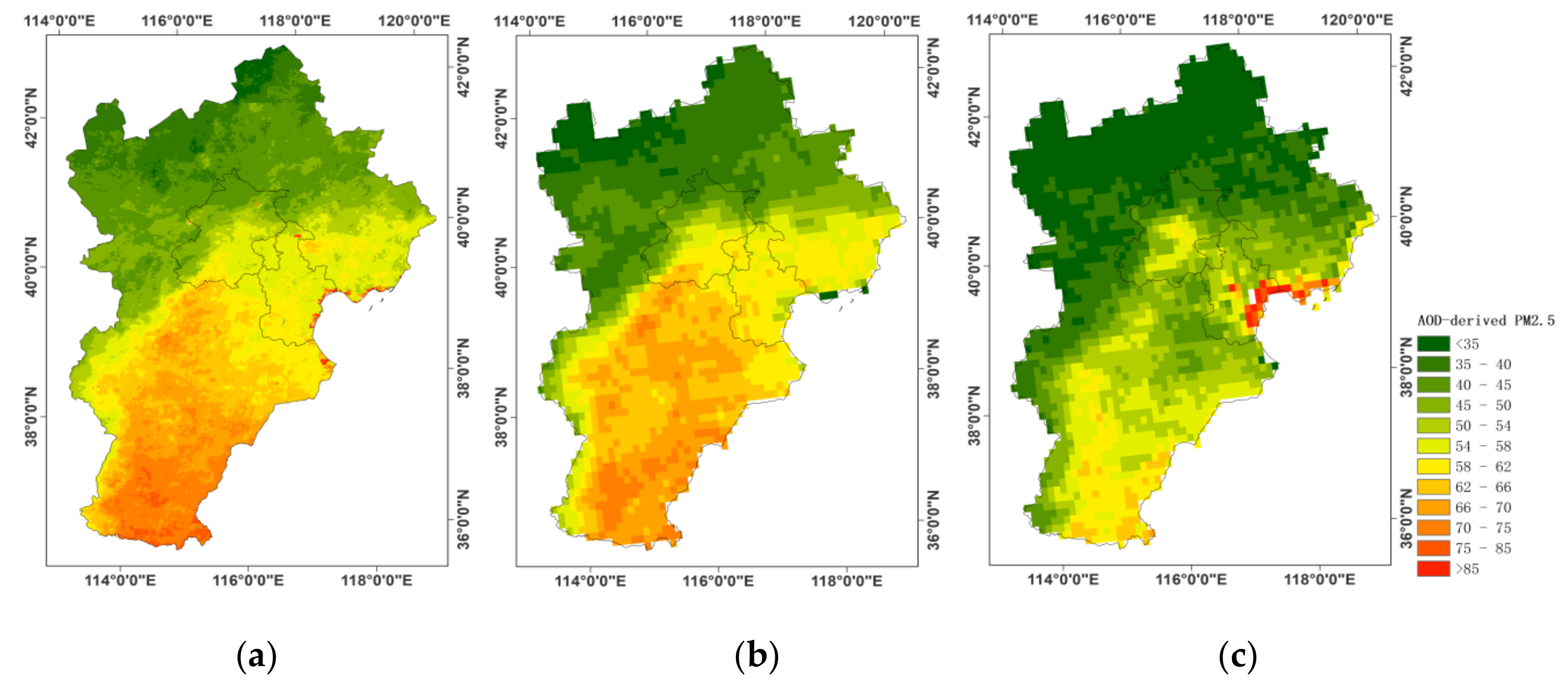
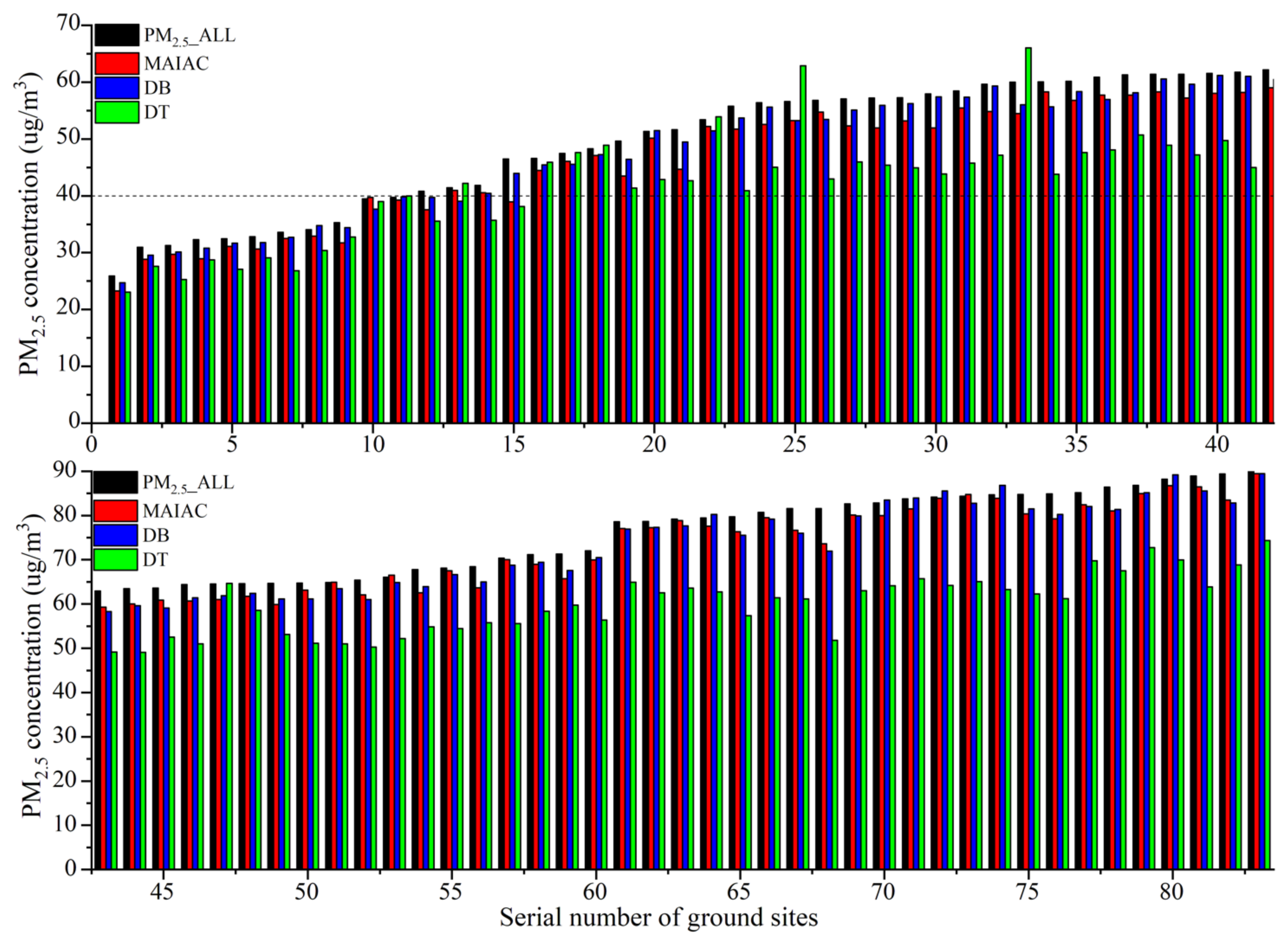
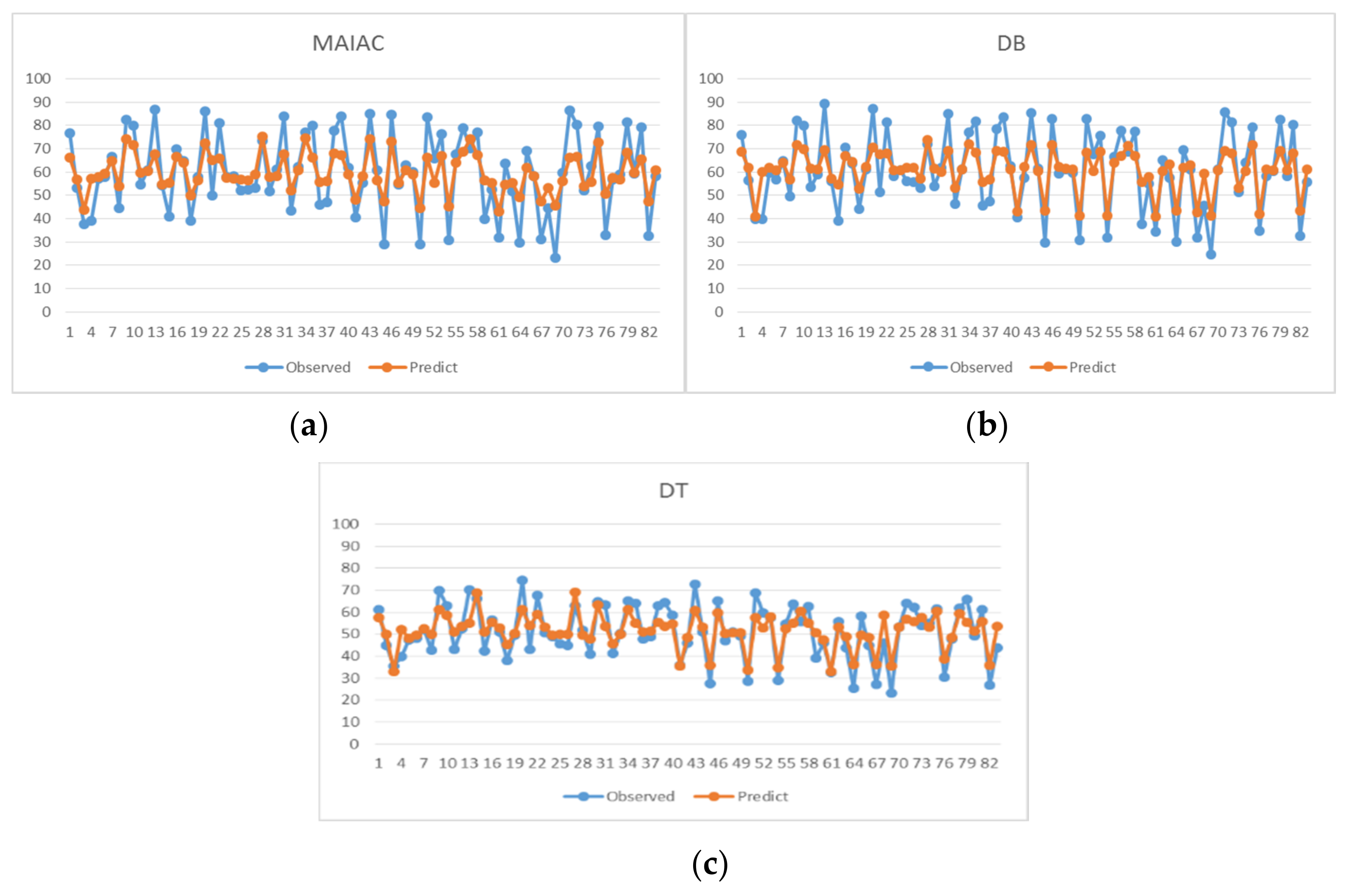
| Algorithm | Spatial Resolution | Retrieval Principle | Application Area | Latest Collection | AOD-PM2.5 Matchups |
|---|---|---|---|---|---|
| DT | 3 km, 10 km | Spectral relationship of surface reflectance | Vegetation | C6.1 | 10811 |
| DB | 10 km | Surface reflectance database | All snow/ice-free | C6.1 | 21356 |
| MAIAC | 1 km | Minimal ratio of spectral surface reflectance | All snow/ice-free | C6 | 16547 |
| Mean | Std. Dev. | Min | Max | Days | ||
|---|---|---|---|---|---|---|
| MAIAC | AOD | 0.49 | 0.51 | 0.02 | 3.27 | 329 |
| PM2.5 (μg/m3) | 59.31 | 52.58 | 1.54 | 488.08 | ||
| DB | AOD | 0.56 | 0.66 | 0.002 | 3.88 | 344 |
| PM2.5 (μg/m3) | 60.49 | 52.33 | 1.54 | 488.08 | ||
| DT | AOD | 0.55 | 0.5 | 0.02 | 3.5 | 305 |
| PM2.5 (μg/m3) | 51.62 | 35.78 | 1.54 | 375.83 |
| Intercept | Slope | P-Value | |
|---|---|---|---|
| MAIAC | 35.48 | 48.54 | <0.0001 |
| DB | 33.63 | 41.18 | <0.0001 |
| DT | 29.21 | 38.43 | <0.0001 |
| AOD Type | Mean | Std. Dev. | Min | Max | Median |
|---|---|---|---|---|---|
| MAIAC | 59.666 | 16.888 | 23.291 | 86.704 | 58.998 |
| 59.668 | 7.97 | 43.172 | 75.136 | 58.217 | |
| DB | 60.393 | 16.461 | 24.705 | 89.16 | 60.449 |
| 60.593 | 8.752 | 40.748 | 73.654 | 61.389 | |
| DT | 51.048 | 12.235 | 23.077 | 74.321 | 50.999 |
| 51.389 | 7.833 | 32.816 | 69.036 | 52.599 |
© 2020 by the authors. Licensee MDPI, Basel, Switzerland. This article is an open access article distributed under the terms and conditions of the Creative Commons Attribution (CC BY) license (http://creativecommons.org/licenses/by/4.0/).
Share and Cite
Li, R.; Mei, X.; Chen, L.; Wang, Z.; Jing, Y.; Wei, L. Influence of Spatial Resolution and Retrieval Frequency on Applicability of Satellite-Predicted PM2.5 in Northern China. Remote Sens. 2020, 12, 736. https://doi.org/10.3390/rs12040736
Li R, Mei X, Chen L, Wang Z, Jing Y, Wei L. Influence of Spatial Resolution and Retrieval Frequency on Applicability of Satellite-Predicted PM2.5 in Northern China. Remote Sensing. 2020; 12(4):736. https://doi.org/10.3390/rs12040736
Chicago/Turabian StyleLi, Rong, Xin Mei, Liangfu Chen, Zifeng Wang, Yingying Jing, and Lifei Wei. 2020. "Influence of Spatial Resolution and Retrieval Frequency on Applicability of Satellite-Predicted PM2.5 in Northern China" Remote Sensing 12, no. 4: 736. https://doi.org/10.3390/rs12040736



